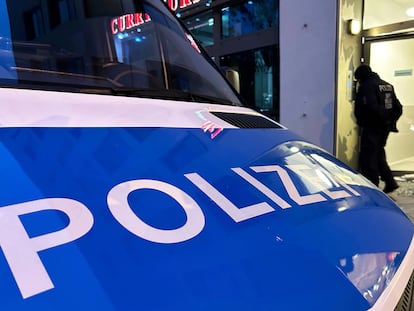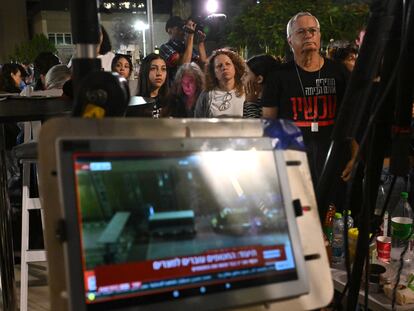Hamas releases third group of hostages as part of truce and says it will seek to extend the deal
International mediators led by the U.S., Egypt and Qatar are trying to extend the cease-fire

The fragile cease-fire between Israel and Hamas was back on track Sunday as the militants freed 17 more hostages, including 14 Israelis and the first American, in a third exchange under a four-day truce that the U.S. said it hoped would be extended. In turn, Israel released 39 Palestinian prisoners, all young men.
Some hostages were handed over directly to Israel, while others left through Egypt. Israel’s army said one was airlifted to a hospital. U.S. President Joe Biden said the elderly woman was “very sick and was in need of immediate medical help.” Hundreds of Israelis draped in flags cheered as freed hostages, waving, arrived at an air force base.
They ranged in age from 4 to 84 and included Abigail Edan, a 4-year-old girl and dual citizen whose parents were killed in the Hamas attack that started the war on Oct. 7. “What she endured was unthinkable,” Biden said of the first American freed under the truce. He did not know her condition. He did not have updates on other American hostages and said his goal was to extend the cease-fire deal as long as possible.
In all, nine children ages 17 and younger were on the list, according to Israeli Prime Minister Benjamin Netanyahu’s office. Three more Thai nationals were released. Separately, Hamas said it released a Russian hostage “in response to the efforts of Russian President Vladimir Putin.” The Russian-Israeli citizen was the first male hostage to be freed.
A fourth exchange is expected on Monday — the last day of the cease-fire during which a total of 50 hostages and 150 Palestinian prisoners are to be freed. Most are women and minors. Many Palestinians view prisoners held by Israel, including those implicated in attacks, as heroes resisting occupation.
“We can get all hostages back home. We have to keep pushing,” said two of Edan’s relatives, a great aunt and cousin, in a statement thanking mediators.
International mediators led by the U.S., Egypt and Qatar are trying to extend the cease-fire that began Friday.
Hamas for the first time said it would seek to extend the deal by looking to release a larger number of hostages. The Israeli army’s chief spokesman, Rear Adm. Daniel Hagari, said it was open to extending the cease-fire if more hostages are released. Israel earlier said the truce can be extended by an extra day for every additional 10 hostages freed, but has vowed to quickly resume its offensive once it ends.
Ahead of the latest release, Netanyahu visited the Gaza Strip, where he spoke with troops. “At the end of the day we will return every one,” he said of the hostages, adding that “we are continuing until the end, until victory. Nothing will stop us.” It was not clear where he went inside Gaza.
This is the first significant pause in seven weeks of war, marked by the deadliest Israeli-Palestinian violence in decades. More than 13,300 Palestinians have been killed, roughly two thirds of them women and minors, according to the Health Ministry in Hamas-ruled Gaza. The war has claimed more than 1,200 Israelis, mostly civilians killed in the initial attack.
Life in captivity
Families from the southern Israeli town of Kfar Aza embraced, cried, and applauded Sunday at the news that hostages from their town had arrived in Israel. More than 70 members of the kibbutz of around 700 people were killed and 18 were kidnapped.
The freed hostages have mostly stayed out of the public eye. Hospitals said their physical condition has largely been good. Little is publicly known about the conditions of their captivity.
Merav Raviv, whose three relatives were released on Friday, said they had been fed irregularly and lost weight. One reported eating mainly bread and rice and sleeping on a makeshift bed of chairs pushed together. Hostages sometimes had to wait for hours to use the bathroom, she said.
Pressure from families has sharpened the dilemma facing Israel’s leaders, who seek to eliminate Hamas as a military and governing power. Hamas and other militant groups seized around 240 people during the incursion into southern Israel that ignited the war. Fifty-eight have been released, one was freed by Israeli forces and two were found dead inside Gaza.
Hammas commander killed
Hamas announced the death of Ahmed al-Ghandour, who was in charge of northern Gaza and a member of its top military council. He is the highest-ranking militant known to have been killed in the fighting. Israel’s military confirmed the death.
Al-Ghandour had survived at least three Israeli attempts on his life and was involved in a cross-border attack in 2006 in which Palestinian militants captured an Israeli soldier, according to the Counter Extremism Project, an advocacy group based in Washington.
Hamas said he was killed along with three other senior militants, including Ayman Siam, who Israel says was in charge of Hamas’ rocket-firing unit. The Israeli military mentioned both men in a Nov. 16 statement, saying it had targeted an underground complex where Hamas leaders were hiding.
The Israeli military claims to have killed thousands of militants, without providing evidence.
Elsewhere, the war has been accompanied by a surge in violence in the Israeli-occupied West Bank. Palestinian health authorities said Sunday that five Palestinians were killed in an Israeli military raid in the West Bank city of Jenin that began the day before. The war toll in the West Bank is now 239.
The Israeli army has conducted frequent raids and arrested hundreds of Palestinians since the start of the war, mostly people it suspects of being Hamas members.
Aid to Northern Gaza
The pause has given some respite to Gaza’s 2.3 million people, still reeling from relentless Israeli bombardment that has driven three-quarters of the population from their homes and leveled residential areas. Rocket fire from Gaza militants into Israel also went silent.
War-weary Palestinians in northern Gaza, where the offensive has focused, returned to the streets. Entire city blocks in and around Gaza City have been gutted by airstrikes.
But those among the hundreds of thousands of Palestinians who fled the north have been turned back by Israeli troops while trying to return to check their homes.
“They open fire on anyone approaching from the south,” said Rami Hazarein, who fled Gaza City.
The Israeli military has ordered Palestinians not to return to the north or approach within a kilometer (around a half-mile) of the border fence. The Palestinian Red Crescent rescue service said Israeli forces opened fire Sunday on two farmers in central Gaza, killing one and wounding the other. An Israeli military spokesperson said they weren’t aware of the incident.
The United Nations says the truce has made it possible to scale up the delivery of food, water, and medicine to the largest volume since the start of the war, but it calls the amount of 160 to 200 trucks a day “hardly enough.”
It was able to deliver fuel for the first time since the war began, and to reach areas in the north for the first time in a month. The Palestinian Red Crescent Society said 50 Egyptian aid trucks crossed through checkpoints to reach Gaza City and northern areas Sunday.
Sign up for our weekly newsletter to get more English-language news coverage from EL PAÍS USA Edition
Tu suscripción se está usando en otro dispositivo
¿Quieres añadir otro usuario a tu suscripción?
Si continúas leyendo en este dispositivo, no se podrá leer en el otro.
FlechaTu suscripción se está usando en otro dispositivo y solo puedes acceder a EL PAÍS desde un dispositivo a la vez.
Si quieres compartir tu cuenta, cambia tu suscripción a la modalidad Premium, así podrás añadir otro usuario. Cada uno accederá con su propia cuenta de email, lo que os permitirá personalizar vuestra experiencia en EL PAÍS.
¿Tienes una suscripción de empresa? Accede aquí para contratar más cuentas.
En el caso de no saber quién está usando tu cuenta, te recomendamos cambiar tu contraseña aquí.
Si decides continuar compartiendo tu cuenta, este mensaje se mostrará en tu dispositivo y en el de la otra persona que está usando tu cuenta de forma indefinida, afectando a tu experiencia de lectura. Puedes consultar aquí los términos y condiciones de la suscripción digital.
More information
Archived In
Últimas noticias
NASA discovers Titan doesn’t have an ocean, but a ‘slushy ice layer’ that increases possibility of life
Innocence lost in the forest of the child soldiers: ‘Each leader of the armed group had his girls’
‘Fallout’ or how the world’s largest company turned an anti-capitalist apocalyptic Western into a phenomenon
From inflation to defending migrants: Eileen Higgins and Zohran Mamdani inaugurate the new Democratic resistance against Trump
Most viewed
- ‘El Limones’ and the growing union disguise of Mexican organized crime
- Christian Louboutin: ‘Young people don’t want to be like their parents. And if their parents wear sneakers, they’re going to look for something else’
- The low-cost creative revolution: How technology is making art accessible to everyone
- ‘We are dying’: Cuba sinks into a health crisis amid medicine shortages and misdiagnosis
- A mountaineer, accused of manslaughter for the death of his partner during a climb: He silenced his phone and refused a helicopter rescue










































